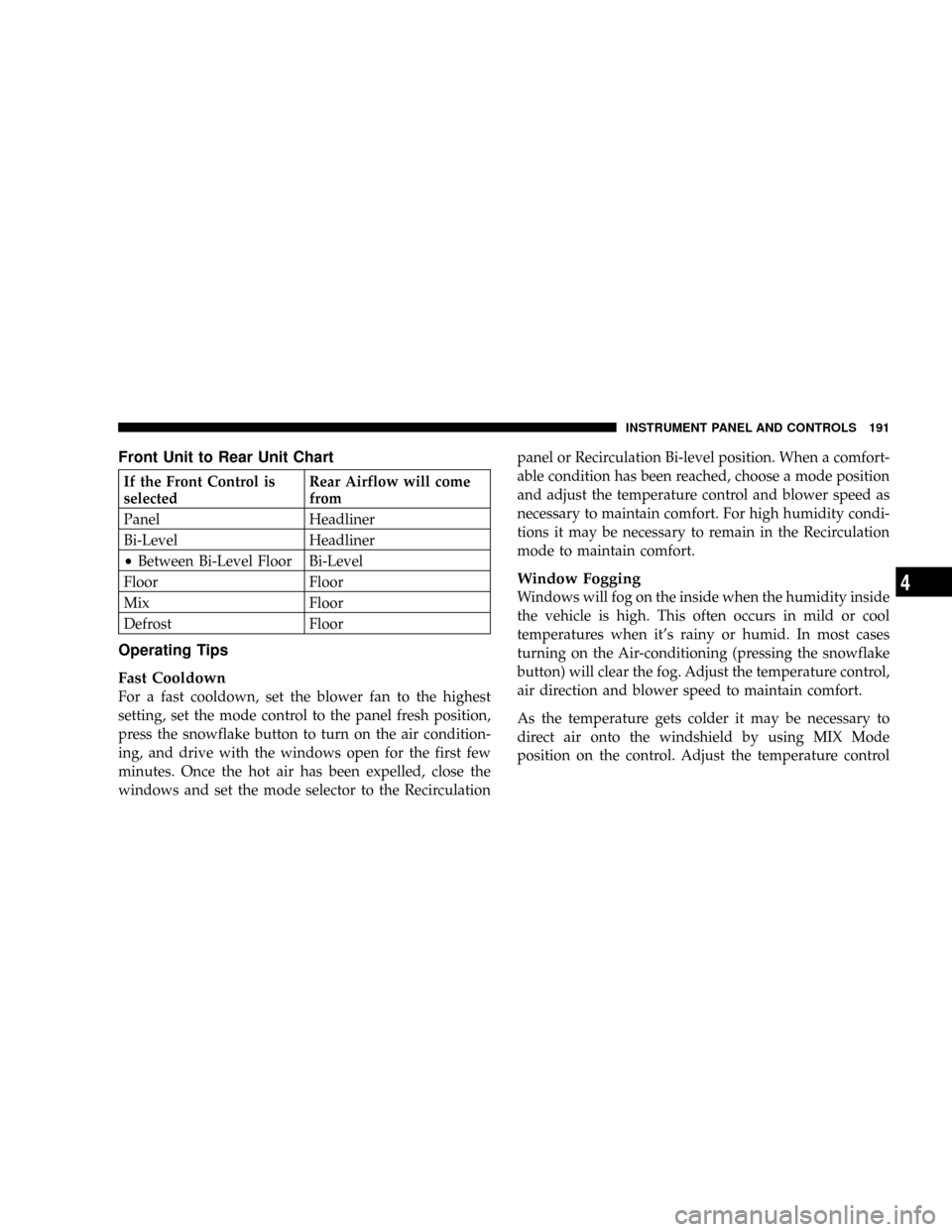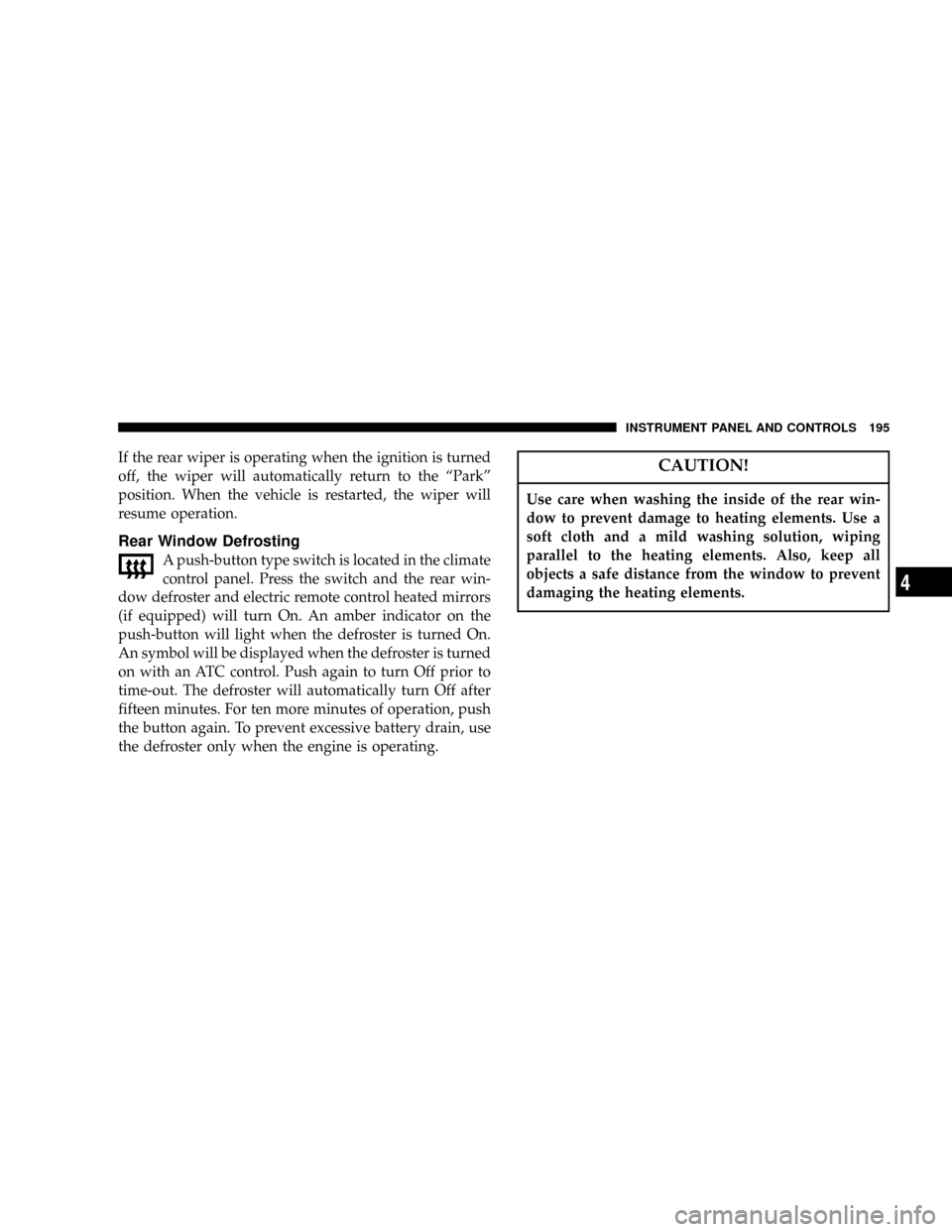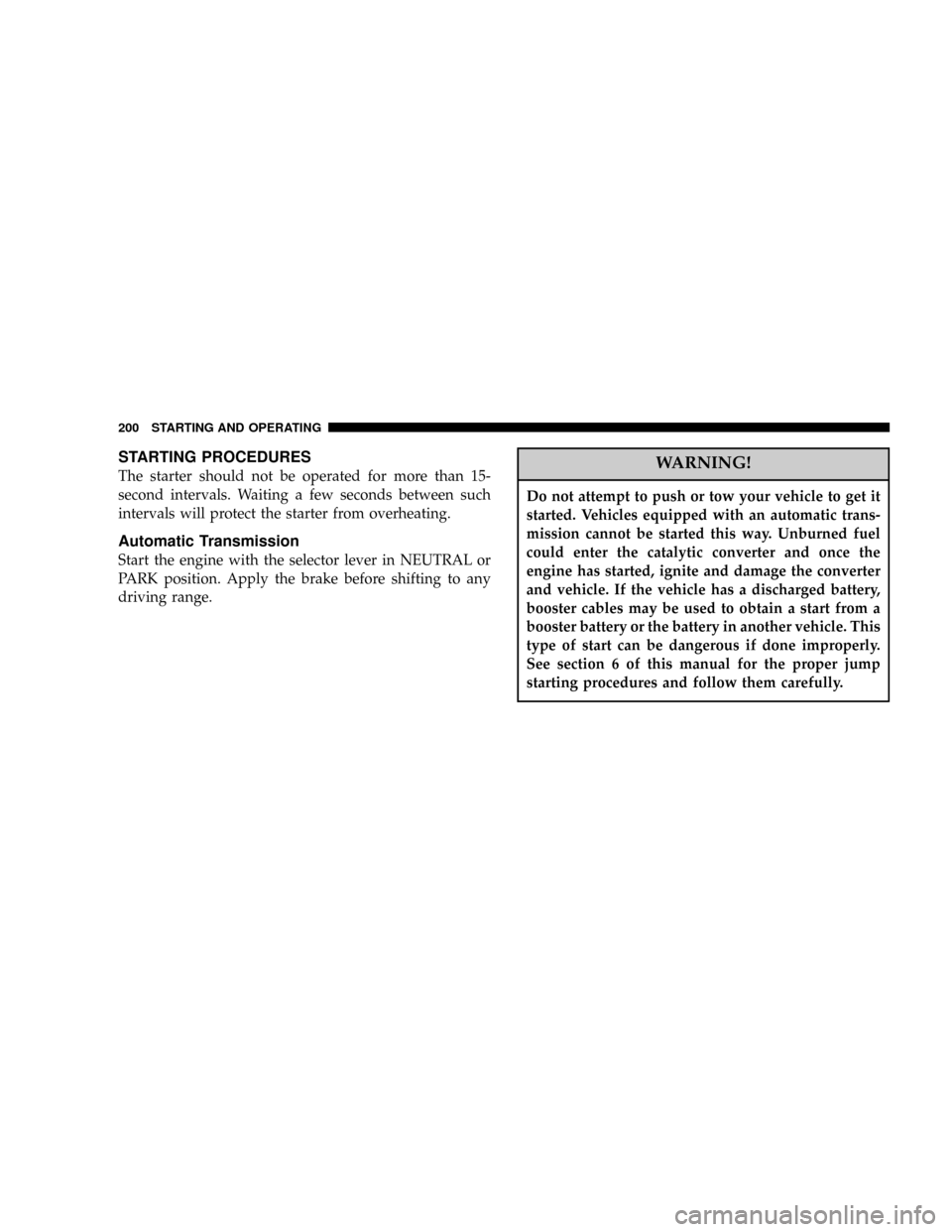DODGE DURANGO 2004 2.G Owners Manual
Manufacturer: DODGE, Model Year: 2004, Model line: DURANGO, Model: DODGE DURANGO 2004 2.GPages: 386, PDF Size: 6.22 MB
Page 191 of 386

Front Unit to Rear Unit Chart
If the Front Control is
selectedRear Airflow will come
from
Panel Headliner
Bi-Level Headliner
²Between Bi-Level Floor Bi-Level
Floor Floor
Mix Floor
Defrost Floor
Operating Tips
Fast Cooldown
For a fast cooldown, set the blower fan to the highest
setting, set the mode control to the panel fresh position,
press the snowflake button to turn on the air condition-
ing, and drive with the windows open for the first few
minutes. Once the hot air has been expelled, close the
windows and set the mode selector to the Recirculationpanel or Recirculation Bi-level position. When a comfort-
able condition has been reached, choose a mode position
and adjust the temperature control and blower speed as
necessary to maintain comfort. For high humidity condi-
tions it may be necessary to remain in the Recirculation
mode to maintain comfort.
Window Fogging
Windows will fog on the inside when the humidity inside
the vehicle is high. This often occurs in mild or cool
temperatures when it's rainy or humid. In most cases
turning on the Air-conditioning (pressing the snowflake
button) will clear the fog. Adjust the temperature control,
air direction and blower speed to maintain comfort.
As the temperature gets colder it may be necessary to
direct air onto the windshield by using MIX Mode
position on the control. Adjust the temperature control
INSTRUMENT PANEL AND CONTROLS 191
4
Page 192 of 386

and blower speed to maintain comfort. Interior fogging
on the windshield can be quickly removed by selecting
the defrost mode.
Regular cleaning of the inside of the windows with a
non-filming cleaning solution (vinegar and water works
very well) will help prevent contaminates (cigarette
smoke, perfumes, etc.) from sticking to the windows.
Contaminates increase the rate of window fogging.
Summer Operation
Air conditioned vehicles must be protected with a high
quality antifreeze coolant during summer to provide
proper corrosion protection and to raise the boiling point
of the coolant for protection against overheating. A 50 %
concentration is recommended.When using the air conditioner in extremely heavy traffic
in hot weather especially when towing a trailer, addi-
tional engine cooling may be required. If this situation is
encountered, operate the transmission in a lower gear.
When stopped in heavy traffic, it may be necessary to
shift into NEUTRAL and press the accelerator slightly for
fast idle operation.
Winter Operation
When operating the system during the winter months,
make sure the air intake, located directly in front of the
windshield, is free of ice, slush, snow, or other obstruc-
tions.
192 INSTRUMENT PANEL AND CONTROLS
Page 193 of 386

Operating Tips Chart
INSTRUMENT PANEL AND CONTROLS 193
4
Page 194 of 386

REAR WINDOW FEATURES
Rear Window Wiper/Washer
A rotating switch located on the climate control
panel turns the rear wiper On or Off. Pressing the
rotating switch inward activates the rear window
washer. Rotating the switch will enable one of five
intermittent delay times for the rear wiper. The delay
times range from 20 to 1 second.
194 INSTRUMENT PANEL AND CONTROLS
Page 195 of 386

If the rear wiper is operating when the ignition is turned
off, the wiper will automatically return to the ªParkº
position. When the vehicle is restarted, the wiper will
resume operation.
Rear Window Defrosting
A push-button type switch is located in the climate
control panel. Press the switch and the rear win-
dow defroster and electric remote control heated mirrors
(if equipped) will turn On. An amber indicator on the
push-button will light when the defroster is turned On.
An symbol will be displayed when the defroster is turned
on with an ATC control. Push again to turn Off prior to
time-out. The defroster will automatically turn Off after
fifteen minutes. For ten more minutes of operation, push
the button again. To prevent excessive battery drain, use
the defroster only when the engine is operating.
CAUTION!
Use care when washing the inside of the rear win-
dow to prevent damage to heating elements. Use a
soft cloth and a mild washing solution, wiping
parallel to the heating elements. Also, keep all
objects a safe distance from the window to prevent
damaging the heating elements.
INSTRUMENT PANEL AND CONTROLS 195
4
Page 196 of 386

Page 197 of 386

STARTING AND OPERATING
CONTENTS
mStarting Procedures.....................200
NAutomatic Transmission................200
NNormal Starting......................201
NEngine Block Heater Ð If Equipped........202
mAutomatic Transmission..................203
NAutomatic Transmission................203
mFour-Wheel Drive Operation...............208
NNV 144 Transfer Case Operating
Information/Precautions................208NShifting Procedure - NV 144 Transfer Case . . . 210
NNV 244 Generation II Transfer Case Operating
Information / Precautions...............211
NShifting Procedure - NV 244 Generation II
Transfer Case........................215
mParking Brake.........................217
mBrake System..........................218
NFour-Wheel Anti-Lock Brake System (ABS) . . . 218
mPower Steering........................220
mRocking The Vehicle.....................221
5
Page 198 of 386

mTire Safety Information...................221
NTire Markings........................221
NTire Identification Number (TIN)..........225
NTire Loading And Tire Pressure...........226
mTiresÐGeneral Information................230
NTire Pressure.........................230
NTire Inflation Pressures.................231
NRadial-Ply Tires......................234
NCompact Spare Tire Ð If Equipped.........234
NLimited Use Spare Ð If Equipped.........235
NTire Spinning........................236
NTread Wear Indicators..................236
NReplacement Tires.....................237NAlignment And Balance.................238
mSupplemental Tire Pressure Information.......239
mTire Chains...........................239
mSnow Tires...........................240
mTire Rotation Recommendations............241
mFuel Requirements......................242
NReformulated Gasoline.................243
NGasoline/Oxygenate Blends..............243
NMMT In Gasoline.....................244
NSulfur In Gasoline.....................244
NMaterials Added To Fuel................245
NAdding Fuel.........................245
NFuel System Cautions..................247
198 STARTING AND OPERATING
Page 199 of 386

NCarbon Monoxide Warnings..............248
mCatalytic Converter.....................249
mVehicle Loading........................250
NCertification Label.....................250
NCurb Weight.........................252
NLoading............................252
mTrailer Towing.........................254
NDefinitions..........................254
NTrailer And Tongue Weight..............256
NGross Combined Vehicle Weight Rating
(GCWR)............................257
NTrailer TowingÐHitches................257
NTrailer Towing Information (Maximum Trailer
Weight Ratings)......................258NTrailer Towing Requirements.............258
NTrailer Tow Wiring....................259
NCooling System TipsÐTrailer Towing.......260
mSnowplow............................261
NDodge Durango Models................261
mRecreational Towing (Behind Motorhome, Etc.)
Of 4X4 Vehicles........................262
NShifting Into Neutral (N)................263
NShifting Out Of Neutral (N)..............265
mTraction.............................267
mEquipment Identification Plate.............267
STARTING AND OPERATING 199
5
Page 200 of 386

STARTING PROCEDURES
The starter should not be operated for more than 15-
second intervals. Waiting a few seconds between such
intervals will protect the starter from overheating.
Automatic Transmission
Start the engine with the selector lever in NEUTRAL or
PARK position. Apply the brake before shifting to any
driving range.
WARNING!
Do not attempt to push or tow your vehicle to get it
started. Vehicles equipped with an automatic trans-
mission cannot be started this way. Unburned fuel
could enter the catalytic converter and once the
engine has started, ignite and damage the converter
and vehicle. If the vehicle has a discharged battery,
booster cables may be used to obtain a start from a
booster battery or the battery in another vehicle. This
type of start can be dangerous if done improperly.
See section 6 of this manual for the proper jump
starting procedures and follow them carefully.
200 STARTING AND OPERATING